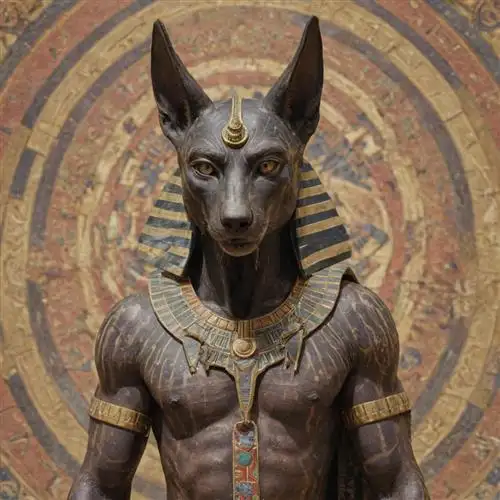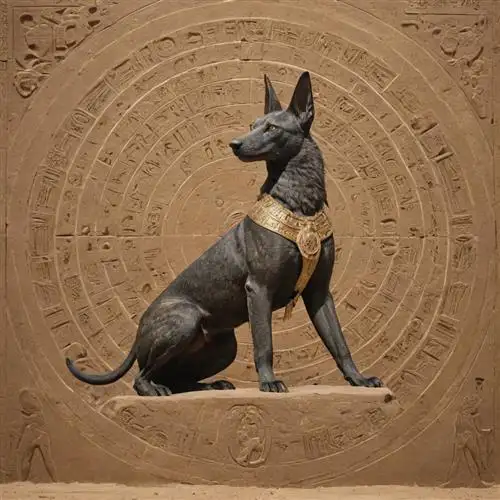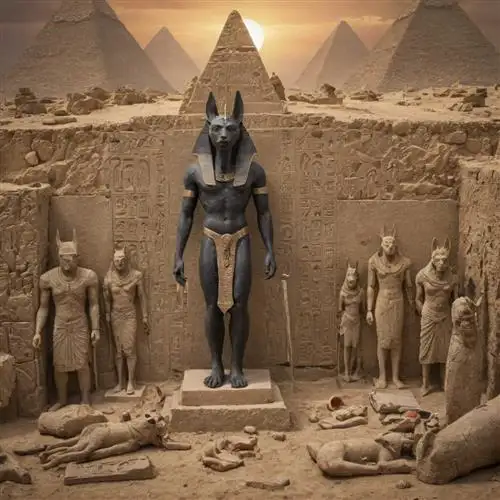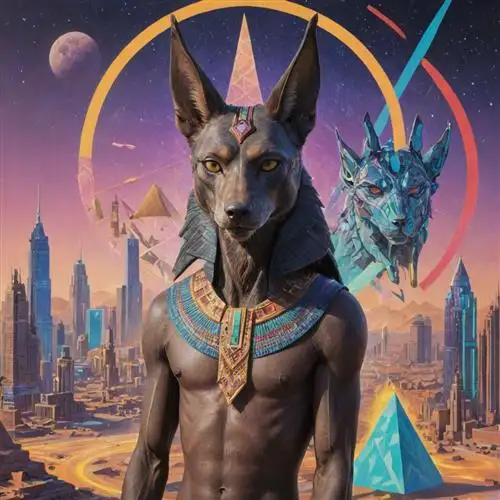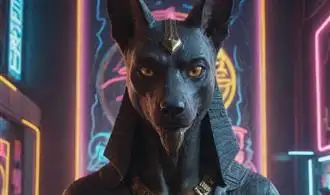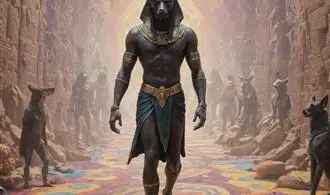
The Jackal-Headed Deity of Ancient Egypt
Anubis, the jackal-headed deity of ancient Egypt, has long been a subject of fascination for scholars and enthusiasts alike. This enigmatic figure, revered for its role in the afterlife, holds a wealth of symbolism and significance that is often misunderstood or oversimplified. As we delve into the intricate iconography of Anubis, we invite you to explore the deeper layers of this captivating deity's legacy.
The jackal-headed form of Anubis is not merely an aesthetic choice but a deliberate representation of the deity's multifaceted nature. Jackals, known for their scavenging habits and nocturnal activities, were believed to have a unique connection to the realm of the dead. Anubis, as the guardian of the necropolis and the embalmer of the deceased, was intimately tied to this liminal space between the living and the departed.
The iconography of Anubis often depicts the deity in a seated or standing position, holding various ritual objects such as the crook and flail, symbols of kingship and authority. These accoutrements reflect Anubis's role as a royal figure, responsible for guiding the deceased through the complex rituals of the afterlife. The deity's association with mummification and the preservation of the body further solidifies its place as a vital link between the mortal and divine realms.
Interestingly, the jackal-headed form of Anubis is not the only representation of this deity in ancient Egyptian art. In some instances, Anubis is depicted with a fully canine head, reflecting the deity's ancient origins as a distinct canine-based god, predating the more familiar jackal-headed variant. This diversity in iconography underscores the fluid and evolving nature of ancient Egyptian religious beliefs, as deities often underwent transformations and syncretizations over time.
The importance of Anubis in the Egyptian pantheon cannot be overstated. As the Anubis Deity Rituals That Will Change Your Life have shown, the deity played a crucial role in the funerary rites and the transition of the deceased into the afterlife. Anubis's presence was ubiquitous, from the embalming process to the final judgment of the soul, ensuring the safe passage of the dead into the realm of the divine.
The Evolution of Anubis Iconography
The iconography of Anubis, the ancient Egyptian god of the dead, has undergone a fascinating transformation throughout history. Initially depicted as a jackal-headed deity, Anubis's representation evolved to incorporate various symbolic elements that reflect the god's complex and multifaceted role in ancient Egyptian mythology.
One of the earliest depictions of Anubis showcases the god's distinct jackal-like features, including the distinctive pointed ears and canine-shaped snout. This portrayal was likely a reference to the jackal's association with the desert, a realm closely linked to the realm of the dead in ancient Egyptian belief systems. Over time, the iconography of Anubis became more refined, with the god's head sometimes featuring a distinct crown or headdress, further emphasizing his divine status.
As Anubis's role expanded beyond his initial function as the god responsible for the embalming and mummification process, his iconography adapted to encompass these additional responsibilities. For instance, Anubis was often depicted holding the crook and flail, symbols of kingship and authority, reflecting his role in the judgement of the dead and their passage into the afterlife.
Another significant development in Anubis's iconography was the incorporation of the ankh, the ancient Egyptian symbol of life. This addition highlighted Anubis's role as a deity who not only presided over the dead but also facilitated the transition from the mortal realm to the afterlife, symbolizing the continuation of existence beyond physical death.
The evolution of Anubis's iconography also reflects the changing artistic styles and preferences of ancient Egyptian culture. During the New Kingdom period, for example, Anubis was often depicted in a more naturalistic and lifelike manner, with a greater emphasis on anatomical details and a more dynamic posture. This shift in artistic representation mirrored the broader trends in Egyptian art during this time, which saw a move towards a more realistic and expressive style.
In addition to the jackal-headed figure, Anubis was occasionally depicted in a more anthropomorphic form, with a human body and the head of a jackal. This variation in iconography likely reflected the god's multifaceted role, as he was seen as a mediator between the mortal and divine realms, possessing both human and animal attributes.
Symbolic Meanings Behind Anubis Imagery
The symbolic meanings behind the iconic imagery of Anubis, the ancient Egyptian god of the dead, are complex and multi-layered. As one of the most prominent deities in the ancient Egyptian pantheon, Anubis held a pivotal role in the afterlife and was deeply revered for his powers of protection and guidance.
At the core of Anubis' symbolism is his association with the process of mummification and the transition from life to the afterlife. As the jackal-headed god who presided over the embalming and preparation of the deceased, Anubis represented the delicate balance between mortality and immortality. His black coloration, often depicted in statues and paintings, symbolized the decaying flesh of the body, while his canine features evoked the watchful, guarding nature of this important deity.
Beyond his role in the mummification rituals, Anubis was also believed to be the guardian of the necropolis, the sacred burial grounds where the dead were laid to rest. His presence at the entrance to the underworld, guiding the souls of the deceased, reinforced his status as a psychopomp, a being who facilitates the journey from the physical world to the spiritual realm.
The iconic imagery of Anubis, with his distinct jackal or canine head, also carried profound symbolic meaning. The jackal was revered in ancient Egypt for its cunning, adaptability, and connection to the underworld, as these animals were often found scavenging in cemeteries. By incorporating this animal into the deity's form, the ancient Egyptians imbued Anubis with a sense of otherworldly power and the ability to navigate the realms of the dead.
Additionally, the scales that Anubis was often depicted holding, used to weigh the hearts of the deceased against the feather of Ma'at (the goddess of truth and justice), symbolized his role as the arbiter of justice in the afterlife. This aspect of Anubis' iconography emphasized his importance in the judgment of the dead and the determination of their eternal fate.
The Role of Anubis in Egyptian Funerary Rites
As the esteemed god of the dead, Anubis held a pivotal role in the intricate funerary rites of ancient Egypt. This jackal-headed deity was responsible for guiding the deceased through the treacherous journey of the afterlife, ensuring a safe passage and a successful transition into the next realm. His presence was paramount in the mummification process, where he would oversee the meticulous preparation of the body, safeguarding the soul and aiding in its rebirth.
Anubis's role extended far beyond the physical aspect of death. He was believed to weigh the heart of the deceased against the feather of truth, a crucial step in the judgment of the soul. This ritual, known as the "Weighing of the Heart," determined the fate of the individual, with Anubis playing the role of the impartial arbiter, ensuring justice and upholding the cosmic order. The outcome of this judgment would either grant the deceased passage into the afterlife or condemn them to eternal damnation.
Furthermore, Anubis was revered for his ability to protect the dead and guide them through the treacherous underworld. As the protector of the necropolis, he ensured the safety of the deceased and their eternal resting places. His depiction as a jackal-headed figure often accompanied the deceased, both in their physical burials and in the elaborate funerary texts and artifacts that were interred with them.
The Influence of Anubis Iconography on Modern Art and Culture
The influence of Anubis iconography on modern art and culture is a testament to the enduring fascination with this ancient Egyptian deity. Anubis, the jackal-headed god associated with mummification and the afterlife, has long captured the imagination of artists, designers, and thinkers alike. From its incorporation into high-fashion runway shows to its presence in contemporary visual art, the iconography of Anubis continues to resonate with audiences around the world.
One of the most striking examples of Anubis' influence can be seen in the world of fashion. Renowned designers have frequently drawn inspiration from Egyptian mythology, using the iconic figure of Anubis to create bold, striking garments and accessories. In recent years, high-profile fashion houses have showcased collections featuring Anubis-inspired motifs, from Givenchy's runway show featuring a model adorned in a jackal-inspired headdress to Balmain's collection that incorporated the god's likeness into luxurious embroidered designs.
The impact of Anubis iconography extends beyond the realm of fashion, however. In the world of contemporary art, the figure of Anubis has become a recurring theme, with artists using the deity's symbolic associations to explore themes of mortality, the afterlife, and the human condition. From the ethereal paintings of Alex Grey, which depict Anubis guiding the soul through the transition of death, to the striking sculptural works of Kiki Smith, which reimagine the god in a modern context, the presence of Anubis in the art world is undeniable.
Beyond the visual arts, the influence of Anubis can also be seen in popular culture. The character of Anubis has appeared in numerous films, television shows, and video games, often serving as a representation of the afterlife or as a mysterious, otherworldly figure. The 5 Fascinating Facts About the Egyptian God Anubis article delves deeper into the specific ways in which Anubis has been depicted and reimagined in modern media.


